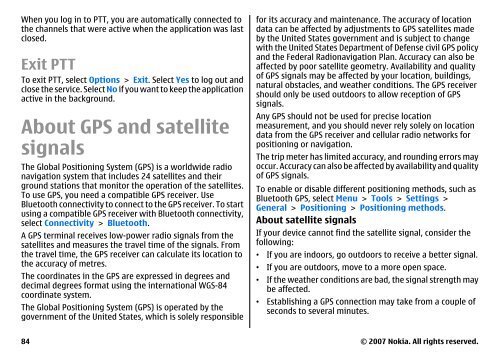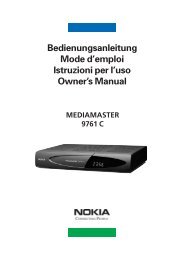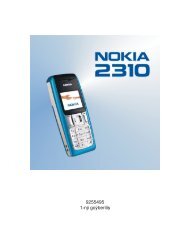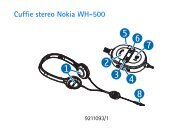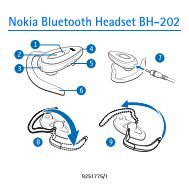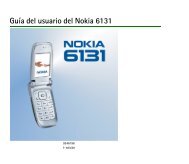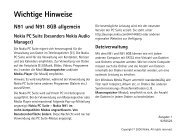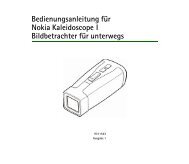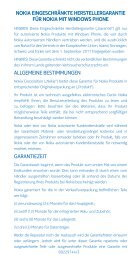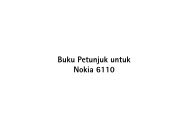E51 User Guide - Nokia
E51 User Guide - Nokia
E51 User Guide - Nokia
You also want an ePaper? Increase the reach of your titles
YUMPU automatically turns print PDFs into web optimized ePapers that Google loves.
When you log in to PTT, you are automatically connected to<br />
the channels that were active when the application was last<br />
closed.<br />
Exit PTT<br />
To exit PTT, select Options > Exit. Select Yes to log out and<br />
close the service. Select No if you want to keep the application<br />
active in the background.<br />
About GPS and satellite<br />
signals<br />
The Global Positioning System (GPS) is a worldwide radio<br />
navigation system that includes 24 satellites and their<br />
ground stations that monitor the operation of the satellites.<br />
To use GPS, you need a compatible GPS receiver. Use<br />
Bluetooth connectivity to connect to the GPS receiver. To start<br />
using a compatible GPS receiver with Bluetooth connectivity,<br />
select Connectivity > Bluetooth.<br />
A GPS terminal receives low-power radio signals from the<br />
satellites and measures the travel time of the signals. From<br />
the travel time, the GPS receiver can calculate its location to<br />
the accuracy of metres.<br />
The coordinates in the GPS are expressed in degrees and<br />
decimal degrees format using the international WGS-84<br />
coordinate system.<br />
The Global Positioning System (GPS) is operated by the<br />
government of the United States, which is solely responsible<br />
84<br />
for its accuracy and maintenance. The accuracy of location<br />
data can be affected by adjustments to GPS satellites made<br />
by the United States government and is subject to change<br />
with the United States Department of Defense civil GPS policy<br />
and the Federal Radionavigation Plan. Accuracy can also be<br />
affected by poor satellite geometry. Availability and quality<br />
of GPS signals may be affected by your location, buildings,<br />
natural obstacles, and weather conditions. The GPS receiver<br />
should only be used outdoors to allow reception of GPS<br />
signals.<br />
Any GPS should not be used for precise location<br />
measurement, and you should never rely solely on location<br />
data from the GPS receiver and cellular radio networks for<br />
positioning or navigation.<br />
The trip meter has limited accuracy, and rounding errors may<br />
occur. Accuracy can also be affected by availability and quality<br />
of GPS signals.<br />
To enable or disable different positioning methods, such as<br />
Bluetooth GPS, select Menu > Tools > Settings ><br />
General > Positioning > Positioning methods.<br />
About satellite signals<br />
If your device cannot find the satellite signal, consider the<br />
following:<br />
• If you are indoors, go outdoors to receive a better signal.<br />
• If you are outdoors, move to a more open space.<br />
• If the weather conditions are bad, the signal strength may<br />
be affected.<br />
• Establishing a GPS connection may take from a couple of<br />
seconds to several minutes.<br />
© 2007 <strong>Nokia</strong>. All rights reserved.


